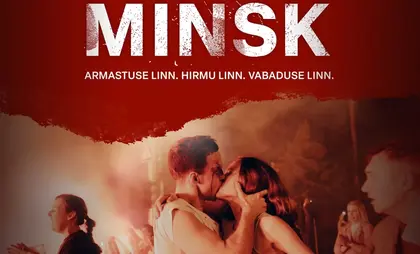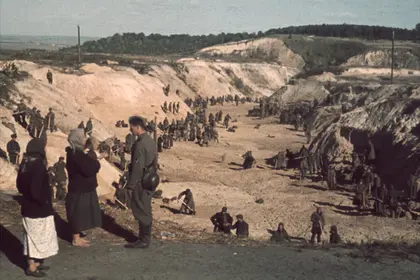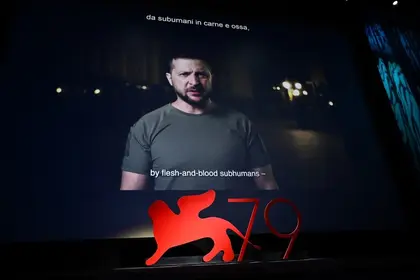Some films can be inherently flawed but still useful by triggering a debate and raising public awareness about an important issue.
Such is “Babyn Yar. Context,” a new archival documentary by Ukrainian director Sergei Loznitsa about the backdrop to the notorious 1941 Holocaust massacre conducted in the Kyiv ravine baring that name.
JOIN US ON TELEGRAM
Follow our coverage of the war on the @Kyivpost_official.
The film also shows the subsequent disregard for this atrocity by Soviet authorities.
Loznitsa reconstructs the events using masterfully restored and re-voiced footage, sound design, documents and some scarce captions of his own.
But the story composition is also his: From Soviets blowing up roads and buildings while retreating, to Nazis killing civilians from Lviv to Kyiv and Lubny; then from the Nazi retreat to Soviets holding trials and execution of German soldiers; and finally to Soviets filling the Babyn Yar ravine with slurry in 1952, despite of the fact that it was a site of mass killings, mostly of Jews, but also Roma, Ukrainians, prisoners of war, psychiatric patients and others.
Desperate locals are caught between the hammer and the anvil: They greet both forces with flowers in national costumes and hastily replace posters of Stalin with Hitler, and vice versa. There is also footage of the Lviv pogroms – when locals beat Jews that were forced by Nazis to clean out a Soviet prison where mass executions had taken place.
The film premiered and received the Golden Eye special mention prize at the Cannes Film Festival in July and was screened on Oct. 5 at the site of the Babyn Yar massacre as part of the official events commemorating the 80th anniversary of the tragedy.

Film Exposes Bloody Protests of Lukashenko Regime
In the same week, the documentary was broadcast on a couple of nationwide TV channels and shown in cinemas in several Ukrainian cities for free. It will also be a part of the Babyn Yar Holocaust Memorial Center, a controversial Russian-sponsored project that financed the film.
Read more: Russian-sponsored Babyn Yar memorial faces tough criticism
But for the millions of potential viewers, “Babyn Yar. Context” may actually not have enough context for understanding the Holocaust tragedies on Ukrainian territory. In fact, it may even be misleading for the unprepared, and especially those influenced by Russian propaganda.
Loznitsa said his primary goal was not to educate, but to “provoke a discussion around complex historical events.” In this regard, his film can be viewed as an artistic provocation but not as an attempt to provide a comprehensive, objective account of these terrible events.
There cannot be any excuse for the crimes against humanity committed by Nazis and those who aided them on Ukrainian territories. But the scope and nature of this collaboration should not be open for manipulation.
A clip from “Babyn Yar. Context” documentary.
What’s missing
Significantly, the Russian-speaking Ukrainian director Loznitsa chose to name his film in English using transliteration from Russian, not the Ukrainian language – “Babi Yar. Context,” not “Babyn Yar. Context.”
The director also seems guided by the Russian, or former Soviet, historiography about World War II. His narrative doesn’t start at the beginning of the war in 1939, when allied Nazi Germany and the Soviet Union jointly invaded Poland, which included today’s Western Ukraine.
Read more: Bohdan Nahaylo – Remembering those who compelled us not to forget Babyn Yar
The film starts tendentiously in 1941, when Germany attacked the Soviet Union – the beginning of what Russians call “The Great Patriotic War” and ignores the repressive role of Soviet “liberators” in Ukrainian areas seized from Poland.
And this approach results in distortion.
When Loznitsa shows locals in Lviv greeting the Nazis, the unprepared viewer won’t realize that they are not welcoming anti-Semites but those they saw as liberators from the Red Terror of Soviet occupation. One invader merely replaced another, but many local Ukrainians hoped that the Nazis would grant them their own independent, or at least autonomous, state.
Loznitsa also doesn’t expand on the circumstances of the Lviv pogroms shown in the film. The despicable act was in fact staged by the Nazis: While forcing Jews to extract the bodies of thousands of political prisoners massacred by the retreating Soviets in local jails, they propagated a lie to the locals that communist Jews were responsible for the murder of their friends and family members.
This is an important detail for another reason. The Nazis were to use the same tactic after taking Kyiv in September 1941. They blamed the blowing up of Kyiv’s center by the retreating Soviets on the Jews and used this as a pretext to round them up and execute them in Babyn Yar.
Read more: Russian filmmaker’s overhaul of Babyn Yar memorial provokes scandal
An important caveat not emphasized by Loznitsa is that most of the archival footage used in the film comes from propaganda newsreels of both sides, which had certain goals. Nazis killed most of the Jews in the pogroms, but the viewer only sees how the locals abuse and beat them, while German officers are presented as onlookers.
The scenes of locals greeting the German and then the Soviet forces were also partly staged as propaganda. They raise their hands synchronously in Nazi salutes, dance or listen to speeches by the generals, but often their faces betray how they really feel about another invader.
Perhaps the strongest caption of the film states that mass shootings of Jews in Babyn Yar on Sept. 29-30 were carried out “without any resistance from the local population.” But it’s hard to imagine how the locals could resist when they didn’t know exactly what would happen to them – both Jews and Ukrainians just days after the Soviets had abandoned them and the Germans marched in victorious.
If they did, perhaps there would be even more Righteous Among the Nations in Ukraine – an honorific used by Israel for people who risked their lives to protect Jews during the Holocaust. It’s the kind of silent resistance that is also not mentioned in the film.
You can also highlight the text and press Ctrl + Enter







